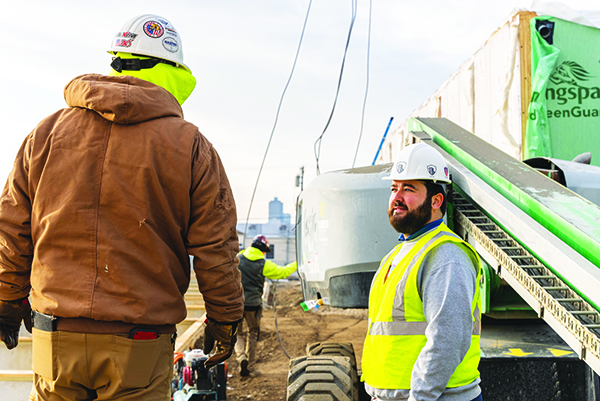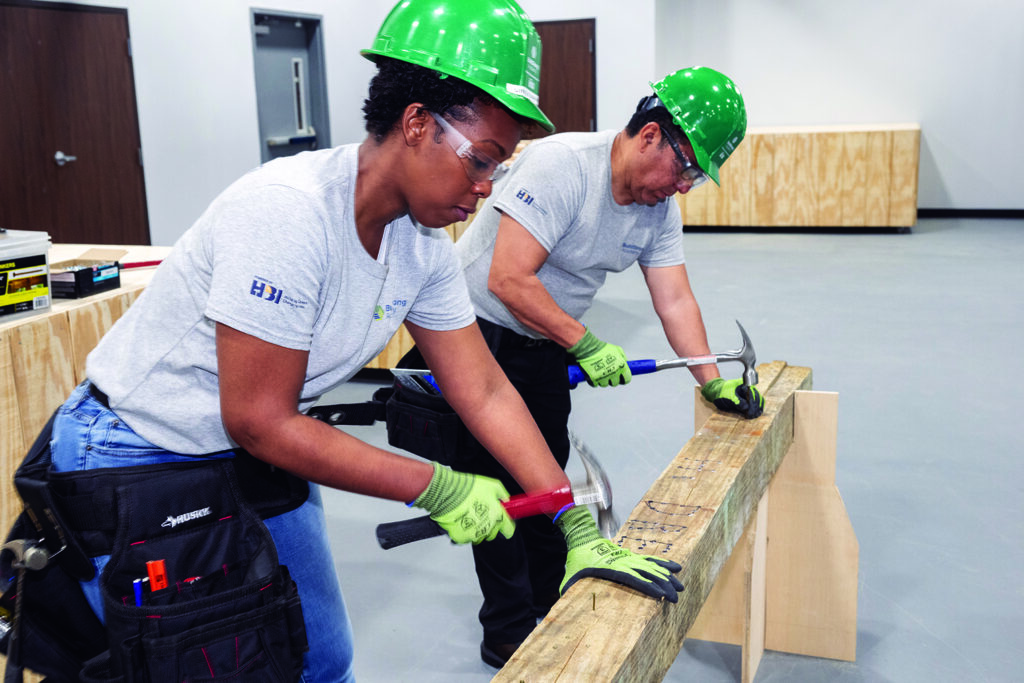Everyone complains about the lack of young workers. These six programs — all focused on offsite and industrialized construction — are doing something about it.
We’re all painfully aware of the skilled labor shortage. “At least 400,000 [construction] jobs will go unfulfilled this year,” says Ed Brady, President and CEO of Home Builders Institute, an arm of the National Association of Homebuilders that has been offering training and education since 1947.
Unfortunately, few people have actually done anything about the problem. “It’s the same stuff we’ve been talking about for 25 years — that we’re going to have a housing crisis, a labor crisis. As an industry we’ve been paying lip service to the workforce shortage, but not really concentrating on solutions.”
Industrialized construction is often cited as a solution to the labor crisis for several reasons: it requires fewer workers; it helps change the perception of construction as dirty and unsteady work, making it more attractive to job and career seekers; it makes the industry more of an option for people who haven’t traditionally been drawn to construction.
But while fewer workers may be needed, industrialized construction still needs people with skills, people who know and understand building construction. “We’ve neglected workforce development in the construction industry. We used to have certain pipelines — like shop classes — that would get students thinking about working with their hands,” says Heather Wallace, Communications Director at Momentum Innovation Group (MIG), an innovation consultancy group. “Now, unless students get into a career tech construction program, they’re lucky if they ever receive any hands-on experience.”
It’s not uncommon for construction companies to offer on-the-job training, and some even have internships and apprenticeship programs. But the industrialized construction segment has its own challenges and needs when it comes to training.

Credit: National Building Museum/ Emily Clack
A Different Focus
One of the key differences in training people to work off-site rather than using conventional jobsite methods is that “the quality of the training is better,” says Marquis Cofer, Director of Customer Experience at Pittsburgh, Pa.-based Module, which does infill development and offsite manufacturing.
Cofer grew up on the jobsites at which his father worked and says, “In the traditional construction setting you often have only one opportunity to do a task before moving on to the next part of the job. Graduating to actually doing that task and not just observing takes time. And if it’s done incorrectly, the work can be harder to undo.”
A factory environment is different. “You’re assigned to a station or specific task, and it allows you to get more practice and better your skills,” says Cofer. “And, since work is broken down into stations in a controlled environment, it’s easier to catch and undo mistakes. Then you can gain expertise in every area a factory has to offer.”
Wallace adds that there’s also the “need to train for the automation aspect, which many factories are using more and more.”
Nolan Browne knows this well. He is the Founding Partner and Head of the Construction/buildings Group at ADL Ventures. ADL recently developed a regional Appalachian workforce training program for the National Science Foundation’s $160 million Regional Innovation Engine initiative.
“It’s a bit of a chicken and egg problem,” Browne says. “It is difficult to propose that real estate developers and owners use industrialized construction or offsite solutions if you don’t have the workforce to run the factories,” he says.
But as construction moves into the factory, Browne wonders what these upgraded jobs look like. In most cases, industrialized construction “still looks like construction, not manufacturing. For our NSF proposal we are rethinking how to manufacture buildings.”
Browne points out that some of the new jobs will require skills that exist today, but other jobs will require merged skills and be different from existing jobs. “An IOC [industrialized offsite construction] designer in the future will need not only an architectural background, but also will need to be an industrial engineer. They will have to be able to design something that can be manufactured.”
The NSF project is developing curricula and job descriptions and is setting up a network with community and four-year colleges. “We have 12 community colleges and five four-year colleges involved in the training network already,” Browne says. “The network will develop the workforce to do the jobs, so investors will want to build more advanced factories and this will lead to industrializing construction.”
Changing the Future Narrative
This article includes six snapshot examples of industry training programs. While these training efforts won’t make a dent in the labor shortage in the immediate future, it’s important to think long-term.
“Every portion of the industry has to invest in training,” says Brady. “That includes the offsite builder, custom home builder, production builder and remodeler. If we don’t do this together, we’re in real trouble. Many companies don’t have enough labor. It’s not just a warm body that’s needed; it’s called skilled labor for a reason. It’s going to take time and money and if we don’t do it collectively, in 2040, we’ll be reporting the same things [we’re reporting now].”

In It for the Long Haul
Even before any hands-on training happens, there’s a huge opportunity to expose young people to both on-site and offsite construction so that they start to think about it as a career.
“You’ve got to be in it for the long haul,” according to Heather Wallace of MIG Innovation. “Middle schoolers are 12-years old. We’ve got to wait another five to seven years before we even know if they’ve done internships, apprenticeships, or gone through a construction focused CTE [Career Technical Education] program. We need to track these kids so we can understand how effective our programs are and what we need to change.”
MIG is creating curriculum focused on offsite construction for middle and high schoolers using funds they received from the US Department of Energy’s Building Technologies Office through the Buildings Energy Efficiency Frontiers & Innovation Technologies award program. They’ve been working with Michigan Virtual to develop a Minecraft education platform that showcases a mock factory and allows users to gain a better understanding of a factory environment.
Additionally, they are working with three factories, three high schools and one middle school to test curriculum that includes offsite construction topics. “We need young people coming into the construction industry who understand advanced technologies, robotics, automation; we’re trying to change the whole viewpoint on what construction is and how they can contribute,” says Colby Swanson, Managing Partner at MIG.
MIG also is helping factories partner with schools and is developing a platform that will house the curricula and resources on best practices for creating those relationships. “There’s not a one-snap fix for everyone, but there are certain steps anyone can take to get started.”

Credit: Courtesy VBC
In-House and Interns
Volumetric Building Companies (VBC), a vertically-integrated volumetric modular construction technology company with factories in several countries, needed to solve a problem internally.
“On the architecture and production engineering teams, in particular, there isn’t currently any school that is providing the exact training or curriculum we need for our employees since our methodologies are so specific,” says Sara-Ann Logan, Vice President of Design at VBC. “There are efforts with workforce development with a focus on tradespeople which are really important, but we believe that this focus is required at all levels from architects, to engineers, to project management, to construction and the trades.”
For the past four years, VBC has been working with several universities in the US, like Drexel in Philadelphia, Pa. and Northeastern and Wentworth in Boston, Mass. VBC employees serve as guest lecturers or work with students in the college classrooms. Students, in turn, apply for internships at VBC.

Credit: Courtesy VBC
They “come into VBC on the project management, production, or design and engineering team. We encourage them to view what we do as one interconnected industry,” Logan says. “When they’re here they’re paid and we treat them like any other full-time employee. They really get their hands dirty on projects.” About 60 percent transition to full-time employment. Specifically for the manufacturing team, VBC offers specialized training at high schools and trade schools local to their facilities.
“We couldn’t find the talent we needed so we came up with this as a long-term solution. We’re invested in it because it gives back to our communities and is the best way we have found to grow and nurture talent that doesn’t otherwise exist,” Logan says.
Higher Ed Prefab
Stonepile is an online-only construction college that offers a master’s degree in prefabrication, modular, and offsite construction as well as a bachelor’s in construction and construction leadership. The master’s program trains students in science, professional development, leadership, organizational change, program development, product quality and scheduling proficiency. The college also offers an associate degree in construction management.
The school is in the process of getting accredited so it can offer financial aid packages. “There’s nothing like it of its kind,” says Dr. Jodi Vermaas, Program Director and a professor, referring to the master’s degree program.
“Students take courses in the psychology of leadership, accounting and the law in relation to construction, so they can be effective project managers and leaders in the field,” Vermaas says. In addition, she adds, there’s a requirement that “twenty-five percent of our curriculum must be in general education in order [for a student] to earn the designation of a bachelor’s degree program instead of a technical degree. At completion, undergraduates are prepared to sit for all the licensing boards to be a General Contractor.”
At the end of the program, Stonepile connects students with internships. “We have a 100 percent” placement rate, Vermaas says.

Credit: Courtesy Module
Partnering with Existing Programs
“Off-site is a unique way to enter the trades,” says Brian Gaudio, Co-Founder and CEO of Module, a part of the Last Mile Network, which developed the Last Mile Lab in 2022.
The Last Mile facility is in Pittsburgh, Pa., and Module partnered with the Trade Institute of Pittsburgh for workforce development and training. Students at the trade institute currently do masonry and carpentry and “we’re spinning up their modular programming,” Gaudio says. Students visit modular factories and worksites to see the finished products.
This spring they’ll be doing hands-on work on a Module ADU product, Gaudio says. ADUs are not legal yet in Pittsburgh, and the building will be a prototype “to show Pittsburgh what’s possible,” Gaudio says. They plan to bring the education and training program to Prince George’s County Maryland and Richmond, Virginia.

Credit: Courtesy Home Builders Institute
Engage Caregivers
The National Building Museum in Washington, D.C. offers myriad youth programs that run the gamut from field trip experiences to in-depth, semester-long out-of-school programs for teens.
One of the organization’s most popular programs is Big Build, which happens each fall. It’s an opportunity for industry leaders, construction firm owners, material providers and trades people to get in front of children and their families, says Jacquelyn Sawyer, Vice President of Education and Engagement. “While it’s fun for seven- and eight-year-olds to drive nails into boards, lay brick, or learn about electrical work and pipe fitting, it’s important to educate their caregivers.”
They’re the ones who need to know about “the nuances of the construction field. We [in the industry] don’t necessarily talk about a plumber or electrician being an entrepreneur, or how they can create wealth for others in their community by being an employer and owning a business. Or how construction workers are able to shape the environment we work and live in. We caregivers and parents must change our narrative.”
Sawyer says that the topics of offsite construction, 3D printing, the fabrication of housing units and affordability are planned for discussion in 2023.
Kids Buy In
In Philadelphia, Pa, Evin Jarrett, a building trades instructor at Mayfair School, is helping solve the labor shortage one middle schooler at a time.
For the past three years, Jarrett has been teaching a trades program for grades 4-8, where students do hands-on work in plumbing, electric, carpentry, masonry, “everything except HVAC,” says Jarrett (who, after 20 years of experience, left the construction industry in 2015 after injuring himself when he fell through two floors during a framing job). Mayfair is Philadelphia’s largest K-8 public school with more than 2,100 students. Jarrett sees 300 of them each year. His is the only program of its kind in Philadelphia.

Credit: Courtesy Evin Jarrett
The students love the program, he says. In the classroom, he blasts music and “kids are up and moving and learning how to use tools safely and properly. It’s like a jobsite. Come on time, problem solve and get the objective for the day done,” he says. Computers are used only for homework.
Jarrett brings in guest speakers to talk about careers and he collaborates with other teachers to show students how the building work relates. “In math, if you’re studying geometry, we talk about Pythagorean theorem. Why we need to know certain things and their significance so students can make the connections.” Each quarter he brings in different discussion topics and off-site is on the list.
Jarrett is so excited about getting kids excited about building that he converted an RV into a mobile shop class. In the summer, he says, he drives from “Reading to Atlantic City, N.J. offering free shop classes just to expose kids to the trades.”

















